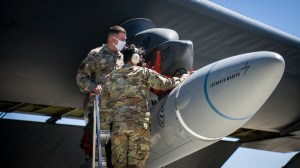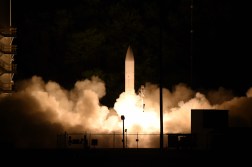Senators warn of insufficiencies in US hypersonic testing infrastructure

Senate Armed Services Committee members are sounding an alarm on the United States’ capacity and infrastructure to test hypersonic systems, as the nation races against China and Russia to develop and field those advanced defensive and offensive weapons capabilities.
Unlike warheads on detectable rockets for ballistic missiles used in previous conflicts, when in-the-making and ultramodern missiles reach and maneuver at hypersonic speeds — or more than 5 times faster than the speed of sound — they become almost impossible to track or deter. America has attempted to master hypersonic flight in fits and starts over the last few decades, but recently sharpened its focus and started massively boosting investments to enable associated assets, largely in response to its competitors’ ambitious programs pushing rapid development.
The SASC’s proposed defense policy bill for fiscal 2023 continues that upward trend in investing in hypersonics, with provisions that would mandate significant funding for the Defense Department’s hypersonics-aligned initiatives. But notably, the lawmakers behind it also revealed they are uneasy about the government’s capacity to assess such sophisticated capabilities and bring them into full fruition.
China, on the other hand, last year shocked the Pentagon and the world with the first reported successful test of a nuclear-capable hypersonic missile, which lawmakers and national security leaders considered a “wake up call” for the U.S.
“The committee notes the [DOD’s] overdue investment in fielding hypersonic defensive and offensive capabilities. The committee encourages additional funding for defensive and offensive capability to enable the department to not just pace, but leap ahead of peer competitors,” members of that committee wrote in a report accompanying their passed version of the National Defense Authorization Act for fiscal 2023.
The added: “However, one of the greatest concerns of the committee is the ability to test hypersonic systems, which requires extensive range space and sophisticated testing capabilities.”
To that end, the congressional cadre called for the defense secretary to provide a briefing to congressional defense committees by March 31, 2023 ”on the capabilities and shortfalls of existing and planned DOD, academia, and industry testing facilities to ensure the on-time development and fielding of these critical hypersonic systems.”
Facilities for this sophisticated type of testing essentially simulate the unique conditions of hypersonic flight, like speed and pressure. China reportedly has the world’s first operational wind tunnel that can assess a full-scale hypersonic missile through the key stages of flight.
SASC’s version of the NDAA for the next fiscal year incorporates a number of hypersonic-related funding proposals — including almost $300 million for the Pentagon’s glide-phase interceptor initiative to combat such capabilities, which is in its early stages and being steered by the Missile Defense Agency.
Separately, while the department’s budget request included $2 million in a specific line for Navy weapons industrial facilities, the committee instead recommended an increase of $25 million for that line, specifically for a hypersonic test facility.
“The committee believes that further investment in hypersonic test infrastructure is vital to the rapid fielding of emerging hypersonic weapons technologies,” the senators wrote in their accompanying report.
They also recommended an increase of $30 million for major range and test facility base improvements.
In their report, the committee members wrote that they understand “that the test and training range in the eastern Gulf of Mexico has aging infrastructure and inadequate instrumented airspace to test the newest generation of weapons and munitions.” They also noted concerns “that open-air test ranges of the major range and test facility base are not capable of supporting the full spectrum of development testing required for current and next generation technologies, including hypersonic and autonomous systems.”
Further, the lawmakers encouraged DOD’s Test Resource Management Center (TRMC) to accelerate the making of launch and down range tracking facilities to support robust testing of both offensive and defensive hypersonic weapons. Alaska, in their view, is one unique geographical location where hypersonic testing could be conducted with “unrestricted flexibility” to meet mission objectives.
This overarching issue is top of mind now, but DOD has been grappling with its deteriorating hypersonics research infrastructure for years.
In a 2014 study, the Institute for Defense Analyses warned that “no current U.S. facility can provide full-scale, time-dependent, coupled aerodynamic and thermal-loading environments for flight durations necessary to evaluate these characteristics above Mach 8.” The nation’s facilities and areas for experimentation have evolved since then, but more recent federal evaluations of the department’s assets to mature these capabilities have not been released to the public.
SASC’s version of the NDAA also aims to require several further assessments related to this topic—including a proposal to require the Defense Secretary to “submit a report on estimated costs for conducting not fewer than one full-scale, operationally relevant, live-fire, hypersonic weapon test of the systems currently under development each year by the Air Force, the Army, and the Navy, once such systems reach initial operational capability.”
It’s not yet clear if the provisions mentioned will be included in the final version of the NDAA. The Senate has yet to vote on this version, while House lawmakers have already passed their chamber’s. The two versions will have to be reconciled in committee before the hefty bill becomes law.






